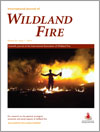International Journal of Wildland Fire
Volume 23
Number 1 2014
Using satellite imagery, we analysed high-severity fire patterns, 1984–2010, in forests of the Sierra Nevada, and found no increase in high-severity fire proportion, area or patch size. This is contrary to previous studies that were based on less complete fire severity data and use of post-fire maps to identify pre-fire vegetation.
Fire severity influences the social, economic and ecological impacts of fire. Weather, topography and fuel age have been identified as important drivers of fire severity, though their relative influence may vary spatially depending on precipitation regimes. Our research reveals that the effect weather, slope and fuel age has on fire severity varies across gradients of annual precipitation. Fire management needs to be dynamic across gradients of mean annual precipitation.
BehavePlus is a point-based fire modelling system that is based on a multitude of mathematical models. It is used for a range of research and fire management applications. An update will facilitate an expansion of fire modelling capabilities.
The Weather Research and Forecasting mesoscale atmospheric model was assessed for its suitability in predicting the fire weather conditions for the 2009–10 New Zealand wildland fire season. Considerable model errors were found for the operational fire weather indices used in New Zealand.
The paper reviews scoring methods to compare a wildland fire simulation with field observations. It introduces two new scoring methods that take into account the dynamics of the simulation. The methods are applied to synthetic cases and two real fires.
Small-area methods are traditionally used to reconstruct historical fire intervals in low-severity fire regimes. We conducted a modern calibration and historical test of several methods in ponderosa pine forests. The all-tree-fire-interval method outperformed others, but a variant of a composite-fire-interval method also worked in historical tests.
The current paper presents the results of the Chinese vegetative biomass burning characteristics using the active fire data of the MODIS at 1-km2 spatial resolution from 2000 to 2011. The results from the MODIS active fire data are more accurate and spatially precise analysis for Chinese fire cases than those from the statistical fire data.
The moisture content of dead fuels is an important determinant of many aspects of bushfire behaviour. This paper reviews research into dead fuel moisture for the period 1991–2012. Topics covered include an overview of fuel moisture physics, field measurements and the development and application of new models.
In a steep shrubland of a temperate-humid region, we evaluated the effect of an experimental fire and two post-fire stabilisation techniques (herbaceous Seeding and straw Mulching) on the amounts of eight trace elements lost with the eroded sediments and the consequences on soil quality in burned and sediment deposition areas.
Identifying a suite of environmental variables rather than relying solely on slope steepness will improve prediction of erosion for environmental assessments. Burning operations need to appreciate the significant influence that fire severity has on sediment movement. Land managers and scientists need to incorporate spatial sampling designs into erosion assessments.
Piñon–juniper woodlands have expanded into big sagebrush steppe of the western United States as a result of reduced fire disturbance. We compared sagebrush steppe recovery following fire on mid-successional and late successional juniper woodlands. The results suggest that native vegetation recovery after fire has greater likelihood of success in mid-successional woodlands than in late successional woodlands.
Fire-killed plants must recover by seed or resprouting. In semi-arid environments this depends on episodic wet periods for establishment. We found the widespread shrub sagebrush recovered faster when fire was followed by wet winters. Sagebrush ecosystems may undergo dramatic transformation if the frequency of consecutive drought years increases.
We found fuel treatment activity was correlated with landowners’ perceived wildfire risk and their financial capacity to conduct treatments. We found landowners’ perceived wildfire risk was influenced by hazardous fuel conditions, the presence of housing or timber assets, past experience with wildfire and membership in forestry and fire protection organisations.




